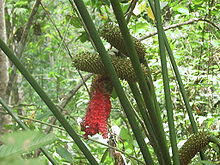Carludovica drudei
| Carludovica drudei | ||||||||||||
|---|---|---|---|---|---|---|---|---|---|---|---|---|

Carludovica drudei in Costa Rica, leaves and cobs |
||||||||||||
| Systematics | ||||||||||||
|
||||||||||||
| Scientific name | ||||||||||||
| Carludovica drudei | ||||||||||||
| Mast. |
Carludovica drudei is a species ofthe disk flower family (Cyclanthaceae). It grows as a tall, perennial , herbaceous plant and is native to Central America and northwestern South America.
description
Vegetative characteristics
Carludovica drudei is a vigorous herbaceous plant up to about 3 m high with a short underground stem . The basal, helical , palm-like leaves are stalked 1.5–2 m long. The fan-shaped leaf blade is about a meter in diameter and about as wide as it is long or slightly wider. It is deeply hand-shaped into three to four wedge-shaped, longitudinally folded sections. These are regularly slit in front into narrow, pointed, 7-15 cm long sections or irregularly divided even deeper. A pair of small callus-like thickenings are present or absent at the base of the spread.
Generative characteristics
The gender distribution is single sexed ( monoecious ). The piston-shaped inflorescences are stalked 40–50 cm long. At flowering time they are white, narrowly cylindrical, 11–12 cm long and approx. 1.5 cm thick. Immediately below the inflorescence there are four, more rarely three sheath-like bracts , which envelop the piston before opening and then fall off. The small, radially symmetrical flowers are arranged in regular groups on the bulb, a sitting female flower is always surrounded by four short-stalked male flowers that are not fused together.
The male flowers have a flower base that gradually narrows into the short flower stalk, and a multi-toothed, cup-shaped flower cover . The inconspicuous tepals have a resin gland on the outside . The numerous stamens are fused together with their stamens at the base. The basifix, that is, the anthers attached to their base, consist of two counters that open lengthways. The flowers wither after blooming and fall off.
The female flowers have an inconspicuous, four-part inflorescence and four carpels , the laterally compressed stigmas of which are fused together in a cross shape. During flowering, there are also four white, several centimeters long, thread-like staminodes (transformed stamens) in the female flowers , which are located in the corners between the carpels.
From the inflorescence a 15 to 26 cm long and 2 to 4 cm wide piston-shaped fruit cluster forms , on which the 5 to 6 mm long green bracts of the female flowers sit on the outer cover . Inside there is a red pulp in which the seeds are embedded. When ripe, the shell of the fruit bulb tears open, making the pulp with the seeds visible from afar. It is believed that this is intended to attract fruit-eating birds in order to take over the spread of the seeds.
distribution and habitat
Carludovica drudei occurs in Central America in two sub-areas, on the one hand in southern Mexico ( Tabasco , Chiapas ) and in Guatemala , on the other hand in Costa Rica and Panama . In Costa Rica it is mainly found on the Pacific slope. The species avoids dry forest areas , which is probably due to the absence in Nicaragua and Honduras . Along the northwest coast of South America, the area extends from northwestern Venezuela ( Zulia ) over the north and west of Colombia to Ecuador .
Carludovica drudei grows in the area of tropical rainforests and cloud forests , from sea level up to 1700 m . The species also colonizes secondary forests .
Flower biology
In the night before blooming, the thread-like staminodes unfold, envelop the blooming cobs and release fragrances to attract small beetles, especially weevils of the Derelomini tribe , but also short-winged species . In the morning, these beetles penetrate between the male flowers to the female flowers hidden below. The beetles lick a sweet juice from the base of Staminodien and the scar is released, and sprinkle it flowering. They stay inside the inflorescences for a day and the following night, mate and lay their eggs. The next morning they crawl outside and get a load of pollen from the surrounding male flowers with which they pollinate the next plant they visit. The male flowers and staminodes fall off after flowering.
Taxonomy
Carludovica drudei was described by the English botanist Maxwell Tylden Masters in 1877 . The first description was based on a plant from Colombia cultivated in England.
etymology
The specific epithet pays tribute to the German botanist Oscar Drude , who supported the first describer in identifying the plant and recognized the independence of the species. The genus Carludovica was named in honor of the Spanish royal couple Charles IV and Maria Luise ( lat. Ludovica ).
swell
- BE Mutton: Cyclanthaceae. In: BE Hammel, MH Grayum, C. Herrera, N. Zamora (eds.): Manual de plantas de Costa Rica. Vol. II: Gimnospermas y Monocotiledóneas (Agavaceae – Musaceae). Missouri Botanical Garden Press, St. Louis 2003, ISBN 1-930723-22-9 , pp. 424-455. (on-line)
- RE Woodson, RW Schery: Cyclanthaceae. In: Flora of Panama. Part II, Fasc. 2. In: Annals of the Missouri Botanical Garden. 30, 1943, pp. 396-403. (on-line)
Individual evidence
- ↑ Carludovica drudei , Herbarium specimens at Tropicos.org. Missouri Botanical Garden, St. Louis, accessed April 16, 2013.
- ^ Carludovica drudei , distribution at Tropicos.org. Missouri Botanical Garden, St. Louis, accessed April 16, 2013.
- ↑ a b MT Masters: New Garden Plants. Carludovica Drudei, Mast., Sp. nov. In: Gard. Chron. Vol 8, 1877, pp. 714–715, figs. 136, 139. (online)
- ↑ H. Ruiz-López, JA Pavón: Florae Peruvianae, et Chilensis prodromus. Madrid 1794, p. 146. (online)

